2018 Adventures
Today's Garmin Step Milage: 12 km
We experienced a little jet lag during the night, but not too bad. I think we are well onto our way into the European time zone.
With a full kitchen and coffee maker available we were able to get up and make breakfast before heading out for the day. Fresh scrambled eggs, aged cheddar and fruit for breakfast will set up pretty good for the day. Our host has left many amenities for our use while we are there, right down to items to make a pasta dinner for our first night in Budapest. Coffee, Tea, spices, olive oil and even 2 bottles of Rose wine were in the fridge chilling for us for our use while were there - how thoughtful!
As you head out of our place, turn left out the door, go to the end of the block and turn left the basilica is down 1 block. Our location couldn't be more perfect. We are amongst the Four Seasons and many other expensive hotels in the area (our place is not nearly the
brenda stanger
104 chapters
16 Apr 2020
Europe - Budapest
Day 2 - Budapest, Hungary
Today's Garmin Step Milage: 12 km
We experienced a little jet lag during the night, but not too bad. I think we are well onto our way into the European time zone.
With a full kitchen and coffee maker available we were able to get up and make breakfast before heading out for the day. Fresh scrambled eggs, aged cheddar and fruit for breakfast will set up pretty good for the day. Our host has left many amenities for our use while we are there, right down to items to make a pasta dinner for our first night in Budapest. Coffee, Tea, spices, olive oil and even 2 bottles of Rose wine were in the fridge chilling for us for our use while were there - how thoughtful!
As you head out of our place, turn left out the door, go to the end of the block and turn left the basilica is down 1 block. Our location couldn't be more perfect. We are amongst the Four Seasons and many other expensive hotels in the area (our place is not nearly the

same price per night.. thank goodness).
As we wandered by St Stephen's Basilica we noticed it was open for the public. Many times in the evening it is closed for a concert; so we took advantage of the opportunity and wandered in. The Saint Stephen Basilica has played an active role in the musical community since its consecration in 1905. The head organists of the church have always been very highly regarded musicians. In the past century the Basilica has been home to choral music, classical music as well as contemporary musical performances. The Basilica choir performs often in different parts of Europe as well as at home. In the summer months they perform every Sunday. During these months you can see performances from many distinguished Hungarian and foreign organ players alike.
The church is named after Saint Stephen I of Hungary, the first King of Hungary (c. 975–1038), whose "incorruptible" right hand is said to be housed in the reliquary. This is the most important church building in Hungary, one of the most significant tourist attractions and the third highest church in Hungary.

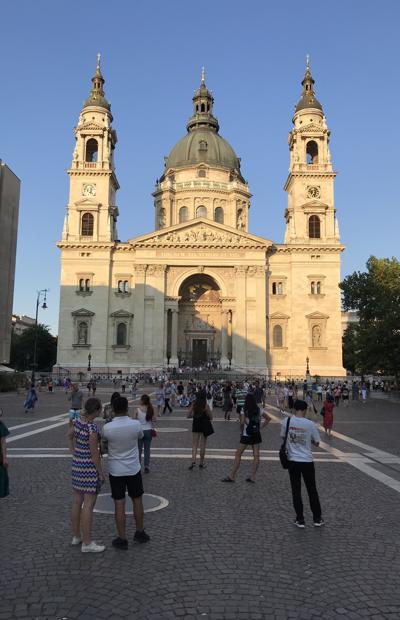
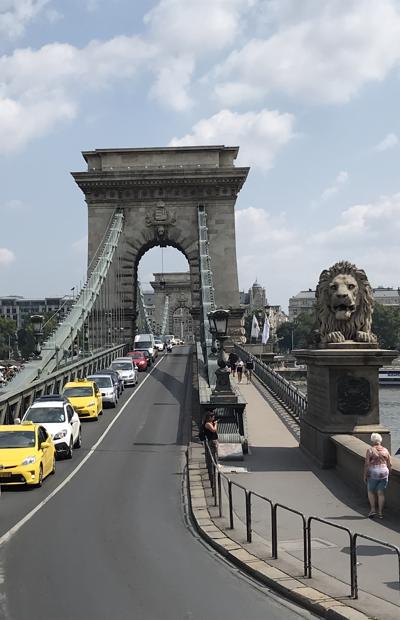
Equal with the Hungarian Parliament Building, it is one of the two tallest buildings in Budapest at 96 metres (315 ft) - this equation symbolises that worldly and spiritual thinking have the same importance. The architectural style is Neo-Classical; it has a Greek cross ground plan. The façade is anchored by two large bell towers. In the southern tower is Hungary's biggest bell, weighing over 9 tonnes. Its predecessor had a weight of almost 8 tonnes, but it was used for military purposes during World War II. Visitors may access the dome by elevators or by climbing 364 stairs for a 360° view overlooking Budapest.
From there we headed to the main street and hopped on the Hop-on-Hop-off tour bus. This is the best way to see the city when you have a small amount of time to see it all. The bus travelled for around 2 hours with 26 stops available. We travelled around until we got to the Central Market and decided that this would be the end our bus tour. The views from the bus were spectacular. You get the commentary and a birds eye view of all of the sites in Budapest. The package is for 48 hours and includes 2 routes and a river cruise. We will definitely use it for a way to get around Budapest.
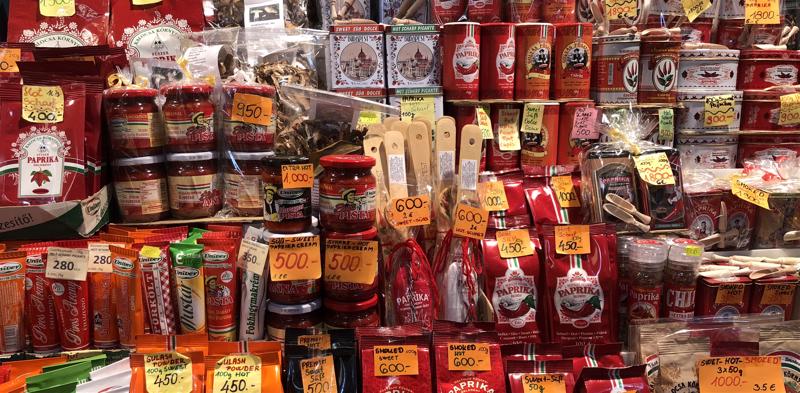
The Central Market is a great place to check out a variety of produce, wares and tourist trinkets; not to mention people watching. They do have a cafe area upstairs where you can get a variety of Hungarian specialities.
After the central market we headed up the Vaci Utca (street)
for some people watching. Vaci Utca has been a shopping street for many years, even back in the times of communism; where the elite would shop and show off their fashion amongst their friends. Today it is lined with restaurants, tourist shops, and many other wares in-between. The best part is that it is a non-vehicle walkway; where a stroll home is quieted from the hustle and bustle of the city.
On our way home from the Central Market we stoped at a friends favourite restaurant -Fatal. We decided to split a typical Hungarian dish - Pörkölt made with pork. Pörkölt is a meat stew in a thick paprika-spiced sauce, similar to ragout; generally translated into English as goulash (not to be confused with goulash soup). It is served with special pasta noodles "nokedli" that is like spatzle. The portions are large so we split the meal and left absolutely stuffed.
As the evening approached we wanted to take in the night scene here in Budapest. There is a great little area in the jewish
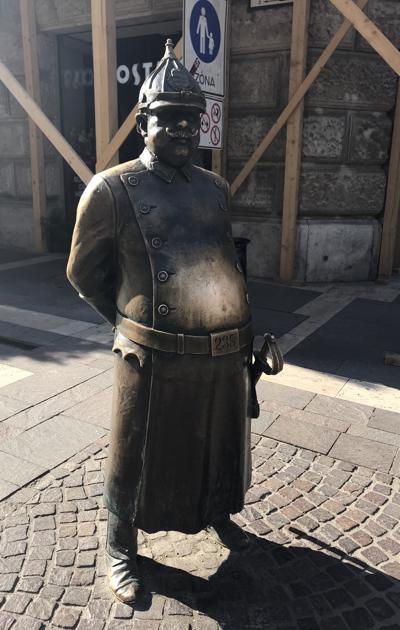
quarter that has a permanent street food market called Karavan. If you enjoy street food it is definitely the place to go. Being that it was Friday night the place was hopping! The busiest stand was selling Langos, so we joined in and shared the "classic" with sour cream and shredded cheese on top.
Hungarians’ all-time favorite dish is unquestionably lángos: a deep-fried flat bread that is certainly something to avoid on a diet. Lángos (deriving from the word flame) is served as a satisfying alternative to bread. The origins of lángos are thought to be due to Turkish influence, while others believe it comes from the ancient Romans. What makes it so beloved is the endless varieties of toppings that come with it. It is usually eaten with garlic sauce, cheese, tejföl (sour cream), or even sausages.
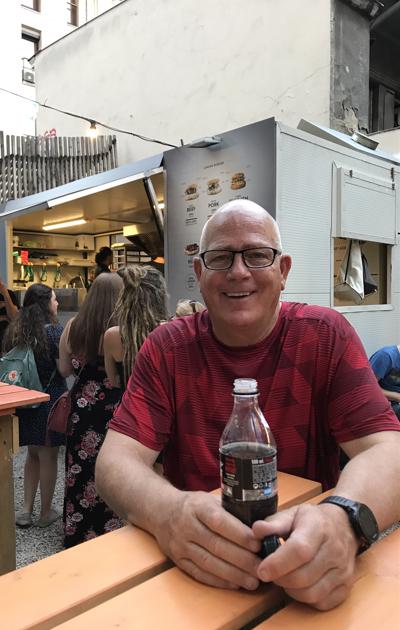

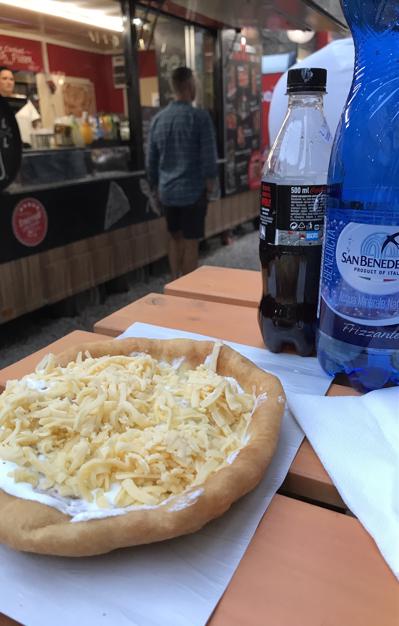

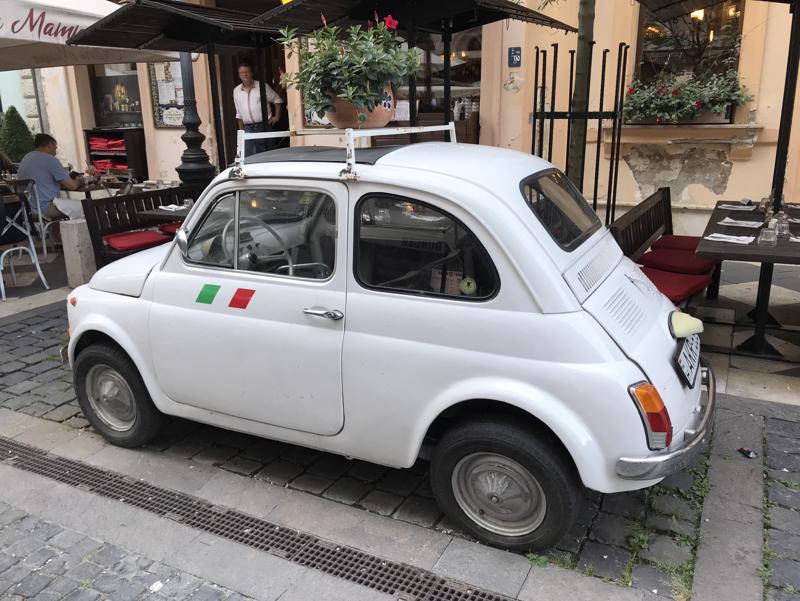

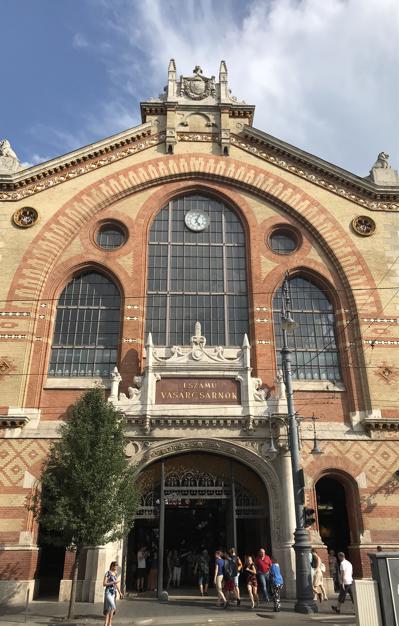

On our way home we took a stroll through the Jewish Quarter and found it to be very interesting. It is lined with restaurants, outdoor bars and lots of action on a Friday night. We stumbled across this market place that is lined with bars and restaurants in a type of a meandering back alley - Gozsdu. The lane way passes through courtyards between buildings but all connected in some fashion. Very interesting area.
We continued on in our journey and wandered toward the Parliament Buildings to see them all lit up at night. What a sight. The building was built over 12 years and about 100,000 people were involved in its construction. The Parliament Building is built in the Gothic Revival style; it has a symmetrical façade and a central dome. The dome is Renaissance Revival architecture. The inside of the parliament is also symmetrical and thus has two absolutely identical parliament halls of which one is used for politics, the other for guided tours. With its height of 96 m (315 ft), it is one of the two tallest buildings in Budapest, along with Saint Stephen's Basilica. The number 96 refers to the nation's millennium, 1896, and the conquest of the later Kingdom of Hungary in 896.
There is a small memorial at the Parliament building to depict the story of the 1956 Revolution. The hungarian revolution, known also

as Hungarian uprising, was an anti-soviet revolt that lasted from the 23 October 1956 to the 11 November 1956. The insurrection was repressed by the soviet tanks and opposed by the ÁVH (State Security Police). Died about 2.600 hungarian from both the sides (pro-against the revolution). The injured were approximately 20.000 and about 250.000 hungarian left from their country. All of which occurred at the Parliament square.
Today was a very full day of adventure, culture and exploring the sites. We definitely have a good picture of what Budapest has to offer.
It is a wonderful city that is accessible by foot and city trams. So far we have decided to explore many of the areas by foot, averaging 12 km/day by walking.
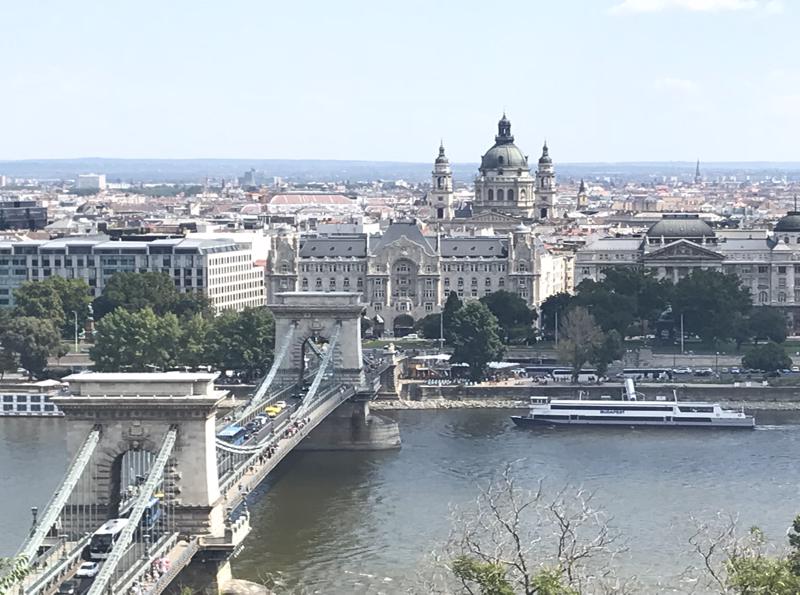
HUNGARIAN BRAISED BEEF WITH PAPRIKA (PÖRKÖLT)
Ingredients
1?2 cup rendered pork lard or vegetable oil
12 oz. oxtail, cut into 1-inch-rounds (have your butcher do this)
2 1?2 lb. beef shoulder, cut into 1-inch cubes
2 large yellow onions, roughly chopped
4 cloves garlic, thinly sliced
2 cups red wine
1?4 cup Hungarian sweet paprika
4 Hungarian wax peppers, stemmed, seeded, and thinly sliced crosswise
2 vine-ripe tomatoes, cored and cut into 1?2-inch wedges
Kosher salt and freshly ground black pepper

Sour cream and gherkins, for serving
Instructions
In a large saucepan, heat the lard over medium-high.
Add the oxtails and cook, turning, until golden brown, about 6 minutes.
Transfer the oxtails to a bowl and return the pan to the heat.
Add the beef and cook, stirring, until brown and caramelized in spots, about 12 minutes.
Using a slotted spoon, transfer the beef to the bowl with the oxtails and return the pan to the heat.
Add the onions to the pan and cook, stirring, until lightly caramelized, about 5 minutes. Stir in the garlic, cook for 2 minutes, then return the oxtails and beef to the pan along with the wine, paprika, peppers, and tomatoes.
Bring to a boil, reduce the heat to low, and cook, covered, until the beef is tender and the sauce is reduced, about 2 1?2 to 3 hours.
Remove the pan from the heat and season with salt and pepper. Serve the pörkölt with a dollop of sour cream and gherkins on the side.
1.
Year of Travel
2.
Sosua - Dominican Republic
3.
Our Adventures So Far...
4.
Beach Life
5.
Our Favourite Restaurants in Sosua
6.
Fun with Friends
7.
Sosua Continued
8.
Sun, Surf and Sand
9.
Samana Peninsula
10.
Sosua Highlights
11.
USA Road Trip
12.
Texas
13.
Texas
14.
Louisiana - NOLA
15.
Louisiana - NOLA
16.
Louisiana - NOLA
17.
Alabama
18.
Alabama to Tennesse
19.
Tennesse - Nashville
20.
Tennesse - Nashville
21.
Tennesse - Nashville
22.
Tennesse - Memphis
23.
Tennesse - Memphis
24.
Tennesse - Memphis
25.
Summer at Home
26.
Westcoast Adventures
27.
Europe
28.
Europe - Budapest
29.
Europe - Budapest
30.
Europe - Vienna
31.
Europe - Vienna
32.
Europe - Vienna
33.
Europe - Prague
34.
Europe - Prague
35.
Europe - Prague
36.
Europe - Berlin
37.
Europe - Berlin
38.
Europe - Berlin
39.
Europe - Salzburg
40.
Europe - Salzburg
41.
Europe - Salzburg
42.
Europe - Salzburg
43.
Europe - Salzburg
44.
Europe - Innsbruck
45.
Europe - Innsbruck
46.
Europe - Bad Ragaz
47.
Europe - Bad Ragaz
48.
Europe - Lindau
49.
Europe - Lindau
50.
Europe - Fussen
51.
Europe - Fussen
52.
Europe - Freising and Munich
53.
San Francisco
54.
San Francisco
55.
San Francisco
56.
San Francisco
57.
San Francisco
58.
San Francisco
59.
Canada Road Trip
60.
On the Road to Ontario
61.
Ontario - Thunderbay
62.
Ontario - Thunderbay
63.
Ontario - Thunderbay
64.
Ontario - Toronto
65.
Ontario - Ottawa
66.
Ontario - Ottawa
67.
Quebec - Montreal
68.
Quebec - Montreal
69.
Quebec - Montreal
70.
Quebec - Quebec City
71.
Quebec - Quebec City
72.
Quebec - Sainte Flavie
73.
New Brunswick - Bathurst
74.
New Brunswick - Shediac
75.
New Brunswick - Shediac
76.
Prince Edward Island - Charlottetown
77.
Prince Edward Island - Road trip
78.
Prince Edward Island - Charlottetown
79.
Prince Edward Island - More exploration
80.
Nova Scotia - Halifax
81.
Nova Scotia - Halifax
82.
Nova Scotia - Halifax
83.
Nova Scotia - Sydney
84.
Newfoundland - Channel-Port
85.
Newfoundland - Rocky Harbour
86.
Newfoundland - Rocky Harbour
87.
Newfoundland - St. John's
88.
Newfoundland - St. John's
89.
Newfoundland - St. John's
90.
Newfoundland - St. John's
91.
Newfoundland - St. John's
92.
Newfoundland - Travelling
93.
Nova Scotia - Sydney
94.
New Brunswick - Saint John
95.
Maine - Portland
96.
Massachessets - Cape Cod via Boston
97.
Massachusetts - Cape Cod
98.
Massachusetts - Cape Cod
99.
Pennsylvania - Clearfield
100.
Illinois - Chicago
101.
Illinois - Chicago
102.
Illinois - Chicago
103.
Heading Home
104.
Our Year at a Glance